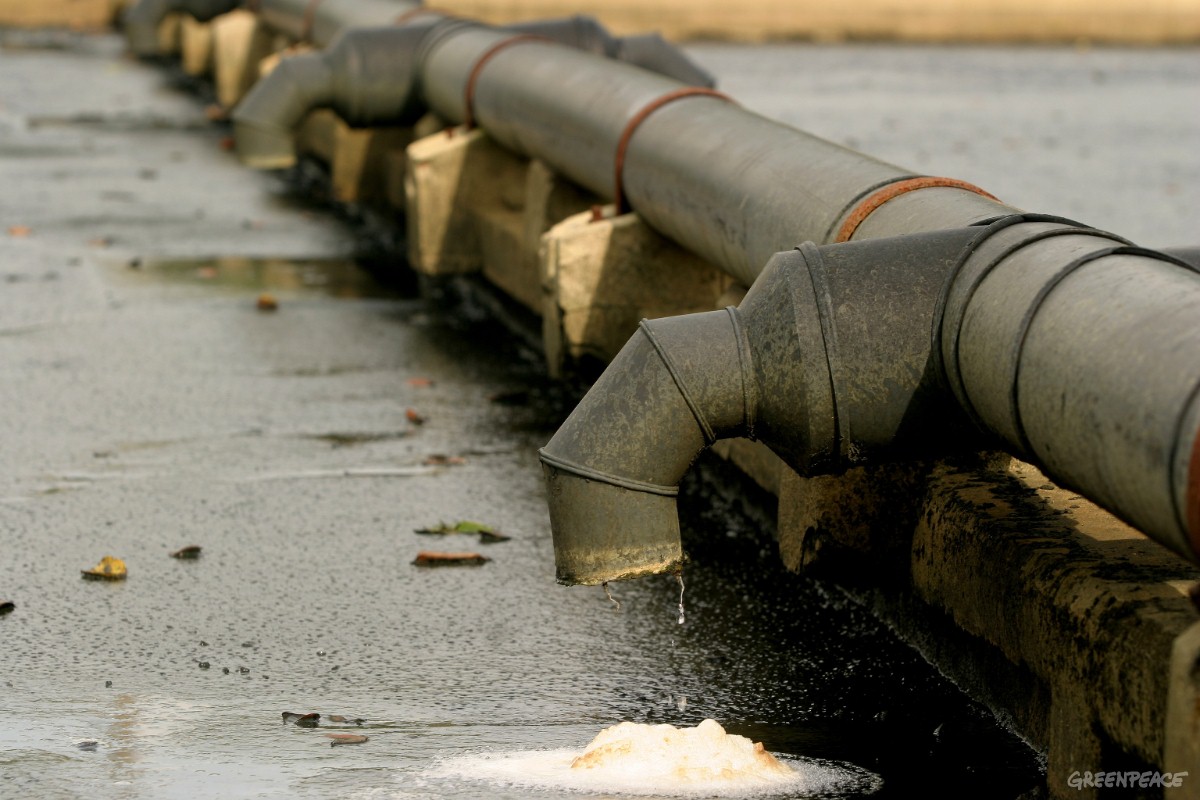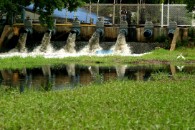Treated wastewater being discharged to public canal from a combined wastewater treatment plant of Navanakorn Industrial Estate.
Water sustains life. The extremely rich biodiversity of
Southeast Asia is a testament to the abundance of freshwater
systems and high rainfallthat support life. The Mekong River of
Mainland Southeast Asia, Chao Phraya of Thailand, and the other
rivers and lakes of the region are important sources of food, water
for various uses, medicines, energy, minerals, etc. More
importantly, these surface waters as well as the underground
aquifers provide communities with drinking water.
Unfortunately, the development path that countries in Southeast
Asia have taken is one that is highly disruptive to the
hydrological cycles. Aquifers, which store precious ground water,
have lost their water-holding capacities due to massive
deforestation such as those experienced in Indonesia and the
Philippines. Over-exploitation of water sources for industrial and
domestic purposes has contributed to the rapid depletion of already
limited freshwater resources. These disruptions have severely
compromised the ability of the forests to “catch” and then “shed”
the water into streams, rivers and reservoirs, as well as the
capacity of aquifers to recharge.
Data from the World Bank shows global per capita renewable
freshwater resource of 7,045 cubic meters per year. Within
Southeast Asia, there is a wide disparity among countries. Lao PDR
and Malaysia have the highest per capita renewable freshwater
resource per year at 35,049 cubic meters and 26,074 cubic meters,
respectively. Thailand and the Philippines are among the lowest
with 1,907 and 1,854 cubic meters, respectively. Meanwhile,
Singapore has no renewable freshwater resource and is importing its
water to meet its demands.
Thus, water scarcity is an issue that communities and
governments must face and address in the next few years. Some
quarters speculate that the next world war will be fought over
water. Hostilities are starting to erupt not only in water-starved
regions in the world but also in areas where abundant freshwater
sources have conflicting uses such as in the Mekong River. At a
smaller scale, communities are now battling companies for rights
and access to drinking water.

But an equally alarming reality is that water quality has been
steadily declining through the years. Siltation from deforestation,
mining and other land conversion activities, saltwater intrusion
from over-extraction of water from underground aquifers, biological
pollution from untreated sewage, chemical pollution from industrial
and agricultural sources, as well as indiscriminate dumping of
garbage on water bodies, have all contributed to degrading water
quality. Pollution has made already scarce water resources even
scarcer. According to the Asian Development Bank, one out of three
Asians still do not have access to a sustainable source of safe
drinking water and 50% still do not have sanitation services.

With dirty, polluted water come increasing cases of water borne
diseases as well as other sickness caused by chemical pollution.
In 1992, the World Health Organization pegged the number of infant
deaths per year from exposure to contaminated waters at 500,000 in
Southeast Asia, while a study in 1997 by the ADB identified lead
from industrial sources as the major contaminant in water
sources.
While there have been many efforts to clean up dirty bodies of
water and waterways, and many governments have made attempts to
enforce water standards (such as the Philippines’ Clean Water Act,
or Thailand’s Pollution Control Act), these can be at best only
interim measures.
If we are to protect our valuable water resources, changes have
to be made in the way we see and treat our environment. The real
solutions to protecting water quality must begin at the sources of
pollution. One such effective and lasting measure is the
implementation of clean production processes. By eliminating the
use of toxics from the very first steps of production, pollution of
water sources can be effectively prevented.
Our constant exposure to polluted fresh water sources-clogged,
or foul smelling river and lakes, as well as contaminated
groundwater-have made water pollution a given, a reality we have
learned to accept. Thus, we focus on technology meant to ‘clean up’
pollution rather than prevent it, and draft laws that merely
regulate the extent of toxicity in water, rather than prohibit it
completely.
An equally alarming reality is that water quality has been
steadily declining through the years. Pollution has made already
scarce water resources even scarcer.
We must learn to unlearn this ‘reality.’ Clean water is the
given we must protect if we are to ensure that our water will
continue to sustain life well into the future.

